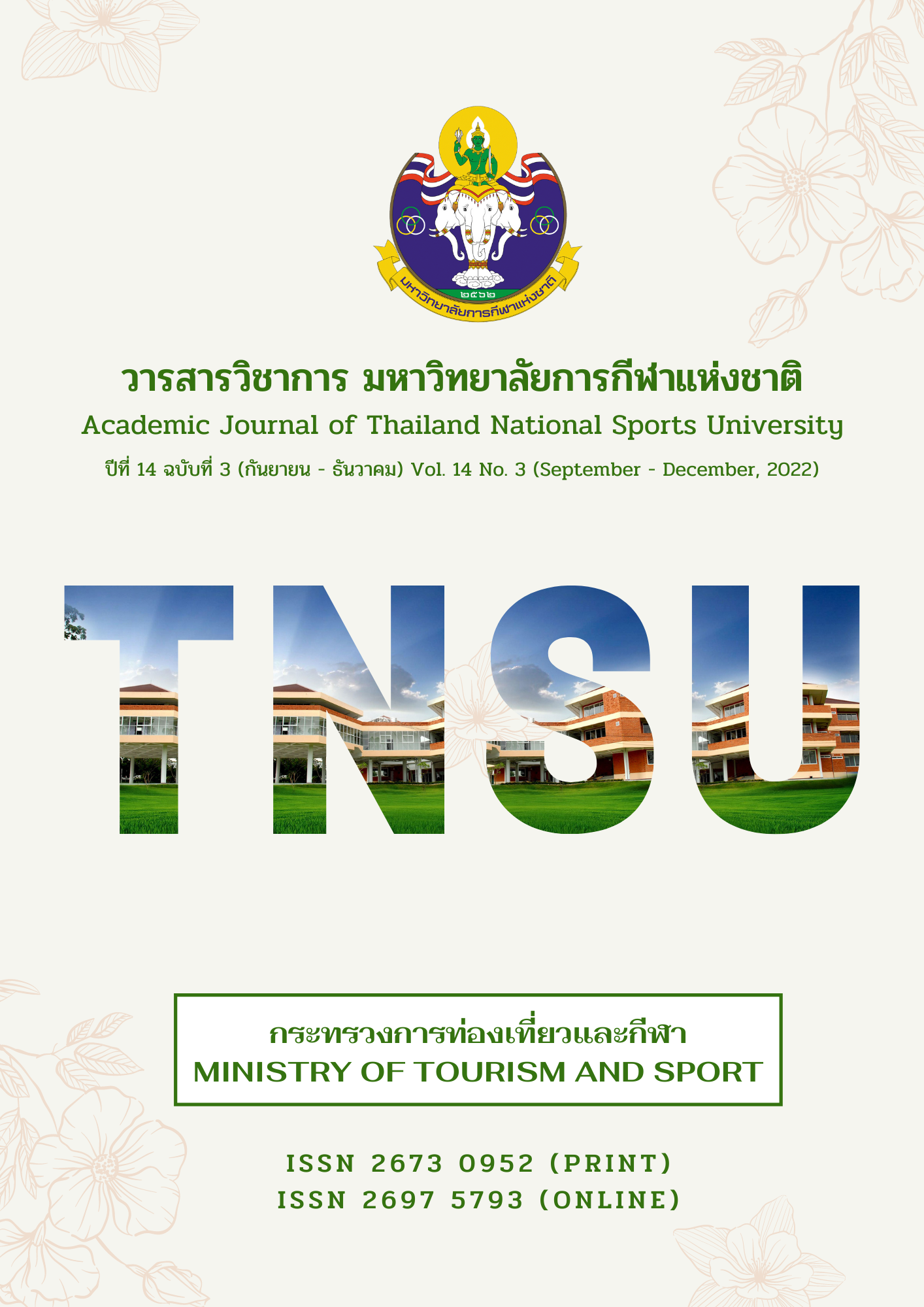ผลของการออกกำลังกายแบบใช้น้ำหนักร่างกายกับแบบแอโรบิกที่มีต่อค่าดัชนีมวลกาย ค่าไขมันที่เกาะอยู่ตามอวัยวะภายในบริเวณช่องท้องและค่าเปอร์เซ็นต์ไขมันของผู้มีภาวะน้ำหนักเกิน
Main Article Content
บทคัดย่อ
การวิจัยครั้งนี้มีจุดมุ่งหมาย เพื่อศึกษาและเปรียบเทียบผลของการออกกำลังกายแบบใช้น้ำหนักร่างกายกับแบบแอโรบิกที่มีต่อฺดัชนีมวลกาย ไขมันที่เกาะอยู่ตามอวัยวะภายในบริเวณช่องท้องและเปอร์เซ็นต์ไขมันของผู้มีภาวะน้ำหนักเกิน กลุ่มตัวอย่าง คือ นักศึกษามหาวิทยาลัยเทคโนโลยีราชมงคลสุวรรณภูมิที่มีภาวะน้ำหนักเกิน (BMI เกิน 22.9 กก. / ม2) ด้วยวิธีเลือกแบบเจาะจง จำนวน 60 คน แบ่งออกเป็น 2 กลุ่ม เป็นกลุ่มทดลองที่ 1 ออกกำลังกายแบบใช้น้ำหนักตัว จำนวน 30 คน และกลุ่มทดลองที่ 2 ออกกำลังกายแบบแอโรบิก จำนวน 30 คน นำกลุ่มตัวอย่างทั้งหมดทดสอบค่าดัชนีมวลกาย ไขมันที่เกาะอยู่ตามอวัยวะภายในบริเวณช่องท้องและเปอร์เซ็นต์ไขมัน ก่อนการฝึกและหลังการฝึกสัปดาห์ที่ 8 นำข้อมูลมาวิเคราะห์ โดยการหาค่าเฉลี่ย ส่วนเบี่ยงเบนมาตรฐาน และทดสอบค่าที ที่ระดับนัยสำคัญทางสถิติที่ระดับ .05 ผลการวิจัยพบว่า หลังการฝึกกลุ่มที่ออกกำลังกายแบบใช้น้ำหนักร่างกายมีดัชนีมวลกาย ไขมันที่เกาะอยู่ตามอวัยวะภายในบริเวณช่องท้องและเปอร์เซ็นต์ไขมัน แตกต่างจากก่อนการฝึกอย่างมีนัยสำคัญทางสถิติที่ระดับ .05 ส่วนดัชนีมวลกาย ไขมันที่เกาะอยู่ตามอวัยวะภายในบริเวณช่องท้องและเปอร์เซ็นต์ไขมันของกลุ่มทดลองที่ 2 ไม่แตกต่างกันทางสถิติ สรุปได้ว่า ผลที่ได้จากการออกกำลังกายแบบใช้น้ำหนักตัวเป็นระยะเวลา 8 สัปดาห์ ส่งผลให้ดัชนีมวลกาย ไขมันที่เกาะอยู่ตามอวัยวะภายในบริเวณช่องท้อง และเปอร์เซ็นต์ไขมันในร่างกายลดลงได้ และเมื่อเปรียบเทียบระหว่างกลุ่มพบว่า หลังการฝึกดัชนีมวลกายกลุ่มทดลองที่ 1 กับกลุ่มทดลองที่ 2 ไม่แตกต่างกันทางสถิติ อย่างไรก็ตามพบความแตกต่างของไขมันที่เกาะอยู่ตามอวัยวะภายในบริเวณช่องท้องและเปอร์เซ็นต์ไขมันระหว่างกลุ่มทดลองที่ 1 กับกลุ่มทดลองที่ 2 อย่างมีนัยสำคัญทางสถิติที่ระดับ .05 โดยกลุ่มทดลองที่ 1 มีไขมันที่เกาะอยู่ตามอวัยวะภายในบริเวณช่องท้องและเปอร์เซ็นต์ไขมันแตกต่างจากกลุ่มทดลองที่ 2 สรุปได้ว่า การออกกำลังกายแบบใช้น้ำหนักร่างกาย 8 สัปดาห์ มีแนวโน้มสามารถลดไขมันที่เกาะอยู่ตามอวัยวะภายในบริเวณช่องท้องและเปอร์เซ็นต์ไขมันในร่างกายมากกว่าการออกกำลังกายแบบแอโรบิก ขณะที่ดัชนีมวลกายไม่แตกต่างกัน เนื่องจากการมีแนวโน้มจากมวลกล้ามเนื้อที่เพิ่มขึ้นจากผลการออกกำลังกายแบบใช้น้ำหนักตัว ซึ่งผู้มีภาวะน้ำหนักเกินมีการสะสมไขมันในช่องท้องและไขมันในร่างกายสูงจึงควรเลือกรูปแบบการออกกำลังกายที่สามารถลดไขมันที่สะสมเฉพาะจุดและไขมันที่สะสมทั่วร่างกาย เพื่อการมีสุขภาพร่างกายที่ดี และลดความเสี่ยงที่อาจเกิดขึ้นในอนาคตจากการมีไขมันสะสมจำนวนมากในร่างกายได้
Article Details

อนุญาตภายใต้เงื่อนไข Creative Commons Attribution-NonCommercial-NoDerivatives 4.0 International License.
บทความที่ได้รับการตีพิมพ์เป็นลิขสิทธิ์ของวารสารวิชาการ มหาวิทยาลัยการกีฬาแห่งชาติ ข้อความที่ปรากฏในบทความแต่ละเรื่องในวารสารวิชาการเล่มนี้ เป็นความคิดเห็นส่วนตัวของผู้เขียนแต่ละท่านไม่เกี่ยวข้องกับวารสารวิชาการมหาวิทยาลัยการกีฬาแห่งชาติ แต่อย่างใด ความรับผิดชอบองค์ประกอบทั้งหมดของบทความแต่ละเรื่องเป็นของผู้เขียนแต่ละท่าน หากมีความผิดพลาดใดๆ ผู้เขียนแต่ละท่านจะรับผิดชอบบทความของตนเองแต่ผู้เดียว
เอกสารอ้างอิง
Adithep Manonatee. (2015). Effects of physical education activities management using a bodyweight resistance exercise program on weight loss and body fat percentage of overweight students at lower secondary school level (Master’s thesis), Chulalongkorn University. Retrieved from http://cuir.car.chula.ac.th/handle/123456789/51314
Charoen Krabuanrat. (2014). Sports Coaching Science. Bangkok: Sinthana Copy Co. Center
Chuenruetai Kanchanachitra. (2014). Thai health 2014. Nakhon Pathom: Institute for Population and Social Research Mahidol University.
Cohen, J. (1988). Statistical Power Analysis for the Behavioral Sciences (2nd ed.). Hillsdale NJ: Lawrence Erlbaum.
Department of Health. (2015). Guidelines for preventing obesity in children. Nonthaburi: Office of Printing Works Veterans Relief Organization.
Khanat Kruthkool. (2010). Operation through the crisis, conquer fat, conquer belly (Revised Edition). Bangkok: Sukhumvit Media Marketing Company.
Narasak Panboot, Thanach Kanokthet, Somchai Chadsri, & Narongsak Noosorn. (2011). The effect of narcotic defensive program on life skill among group of risks 1st year students in secondary school, Sukhothai province. Journal of Nursing and Health Sciences, 4(2), 82 - 90.
National Statistical Office (2019). Survey of Social, Cultural and Mental Health 2018. Bangkok: National Statistical Office.
Natthanan Samphet (2013). Effect of pilates exercise and aerobic exercise on abdominal visceral fat in obese woman (Master’s thesis), Kasetsart University. Retrieved from http://researchconference.kps.ku.ac.th/article_9/pdf/o_sci_ sport02.pdf
Network of Thai people without belly Royal College of Physicians of Thailand. (2015). Guidelines for caring for overweight and obese people. Bangkok: Moh-Chao-Ban Publishing House.
Prem phimai. (2019). Effects of body weight training on health related physical fitness of overweight woman (Master’s thesis), Mahasarakham University. Retrieved from http://202.28.34.124/dspace/bitstream/123456789/451/1/ 57010582004.pdf
Piyawat Ketwongsa. (2020). Manual physical activity at home. Nakhonpathom: Sahamit Printing and Publishing.
Saowaluck Suntralak. (2008). Comparison of the effects of aerobic exercise training and aerobic exercise training with the use of resistance on energy metabolism and performance of overweight women (Master’s thesis), Chulalongkorn University. Retrieved from http://cuir.car.chula.ac.th/handle/123456789/15639
Siwarak Kitchanapaiboon. (2013). Incorrect weight loss behavior of Thai adolescents and young people. Journal of Nursing. 39(4), 179-190.
Somsak Thinkhajee, & Poonsak Poomwiset. (2012). Weight loss behavior of undergraduate students Nonthaburi. Nonthaburi: Ratchaphruek College.
Suthida Kaewtha, Panuwat Khamwangsanga, & Attakiat Kanjanapibulwong. (2020). Situation report of NCDs, diabetes, high blood pressure and related factors 2019. Bangkok: Aksorn Graphic and Design Publishing.
Wichai Ekplakorn. (2017). Thai people's health survey report by physical examination 5th 2014. Nonthaburi: Health Systems Research Institute.


